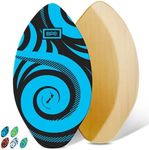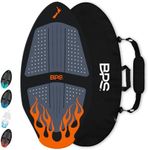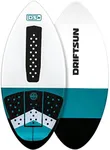Buying Guide for the Best Skimboards For Beginners
Choosing the right skimboard as a beginner can greatly enhance your learning experience and make the sport more enjoyable. Skimboarding is a fun and exciting water sport that involves gliding across the water's surface on a specially designed board. To find the best skimboard for you, it's important to consider several key specifications that will affect your performance and ease of use. Understanding these specs will help you make an informed decision and select a board that matches your skill level, body type, and the conditions in which you'll be skimboarding.Board SizeBoard size is crucial because it affects your stability and control on the water. Skimboards come in various sizes, typically measured in inches. For beginners, a larger board is generally better as it provides more surface area, making it easier to balance and ride. If you're a smaller or lighter person, you might opt for a board around 45-50 inches. If you're taller or heavier, look for a board in the 50-55 inch range. The right size will help you stay on the board and improve your confidence as you learn.
Board ShapeThe shape of the skimboard influences how it performs in different conditions. There are two main shapes: wave-riding boards and flatland boards. Wave-riding boards have a more curved, pointed nose and are designed for riding waves in the ocean. Flatland boards are flatter and more symmetrical, ideal for skimming on shallow water or wet sand. As a beginner, consider where you'll be using the board most often. If you plan to skim on the beach and catch small waves, a wave-riding board is suitable. For inland water bodies or flat beaches, a flatland board is a better choice.
MaterialSkimboards are made from different materials, each offering unique benefits. Common materials include wood, fiberglass, and carbon fiber. Wooden boards are heavier and more affordable, making them a good choice for beginners who are just getting started. They are durable and provide good stability. Fiberglass boards are lighter and more responsive, suitable for those who want to progress quickly. Carbon fiber boards are the lightest and most expensive, offering high performance for advanced riders. As a beginner, a wooden or fiberglass board will provide a good balance of performance and cost.
RockerRocker refers to the curve of the board from nose to tail. A board with more rocker (a greater curve) is easier to maneuver and turn, which can be helpful for beginners learning to control the board. However, too much rocker can slow you down. Boards with less rocker are faster and better for straight-line speed but can be harder to turn. For beginners, a moderate rocker is ideal as it offers a good balance between speed and maneuverability, helping you learn the basics without feeling overwhelmed.
Traction PadsTraction pads are added to the top of the skimboard to provide grip and prevent slipping. They are especially important for beginners who are still developing their balance and control. Some boards come with pre-installed traction pads, while others require you to add them yourself. Look for a board with a good quality traction pad or plan to purchase one separately. The right traction pad will help you stay on the board and reduce the risk of falls, making your learning experience safer and more enjoyable.






















